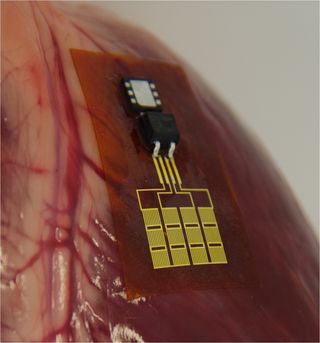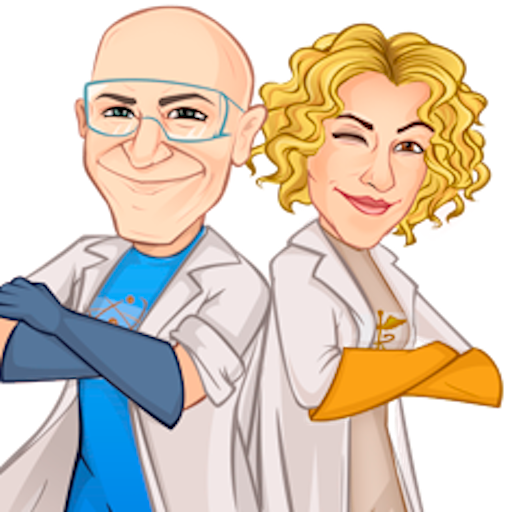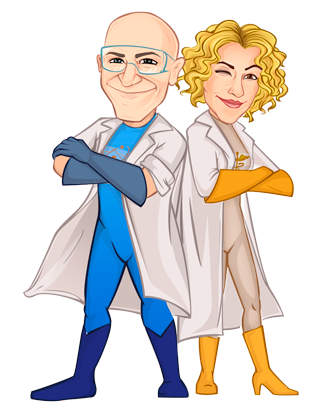Inspiration from an MIT researcher who is harvesting energy from the body itself
On September 18th, 2018, I woke up really excited. My husband and I had an appointment at 9:00 a.m. at the Massachusetts Institute of Technology in Cambridge to interview Dr. Canan Dagdeviren. Being from Paris, France, I had never been inside MIT, but had always dreamed of visiting it. That day, my dream was going to come true. I was thrilled.
After a short taxi ride (short in distance, but long in time, because traffic was heavy), my husband Eric and I arrived at a large, modern building. A big sign reading “Massachusetts Institute of Technology” was above the entrance door. My heart was racing with excitement. My husband and I climbed up the stairs leading to the entrance door and were met in the lobby by a young, thin, beautiful brunette with long hair and strikingly bright, brown eyes, wearing a colorful red and white top over white pants. She had a big smile on her face and, extending her right hand, said: “I am Canan Dagdeviren, welcome to MIT!”
Getting on an elevator to the 4th floor, we followed her to her spacious office.
“My office has Turkish decorations which remind me of my family and my home country” Canan said proudly. Indeed, on a wall above her desk was a very old, handmade carpet.
“This carpet is a gift from my great aunt. It is several hundred years old, and all its colors are generated from flowers. To protect it, I have put it in a vacuum frame,” Canan added with a smile, then taking us along a corridor. “Now let me show you my lab. I had it custom-built with transparent walls.” We arrived outside a large area with transparent, yellowish walls.

“When I was a Ph.D. student in a male-dominated research group, I asked many practical questions, like how do you handle wafers (thin pieces of semiconductor material) without breaking them, how do you mix polymers, how do your wire up devices, etc., but my male lab mates got tired of my questions and stopped answering me, so I spent countless hours from morning to night for months inside labs, watching how seasoned researchers worked. Unfortunately, the walls of labs were not see-through, so I had to gown-up each time I wanted to get inside the sterile labs. I promised myself that when I had my own lab, it would have custom-built transparent walls, so that students like me could learn by watching seasoned researchers from outside the lab without asking any permissions or having to gown-up to get into the sterile environment. I kept my promise, and I had my dream lab built last year. From design to construction, this new lab took 9 months to create. The walls have a yellow tint so that UV light cannot penetrate the transparent walls (the polymers I’m working with could become inactive if UV light gets to them), and there are suction devices in the ceiling to filter out dust particles, keeping the lab under negative pressure. This makes my lab a very clean place so that my work can be as precise as possible.”

I had never seen a lab with transparent yellow walls, and it was indeed fascinating to be able to watch researchers work from outside. Canan’s interview was off to a very good start. I asked her about her personal life and precisely her childhood. What motivated her to come to the United States? Why did she study materials science and engineering? What were her dreams? Then I asked her to describe the different projects she was working on.
The inspiring story of a young girl in Turkey
At the age of 5, Canan, already interested in science, wanted to see atoms, and in order to do so, was smashing stones in her hometown in Turkey. When Canan’s father, who was an accountant, saw Canan smashing stones, he explained to her that humans couldn’t see atoms with their naked eyes, but needed an electron microscope to do so.
A few years later, Canan’s father gave Canan a book about Marie and Pierre Curie, book that changed Canan’s life forever. In that book, Pierre Curie demonstrated that an electric potential was generated when crystals were compressed, and later that the reverse was true, that crystals could change form when an electric field was applied to them. Pierre Curie had discovered piezoelectricity (electricity resulting from compression or pressure) in 1880, and Canan, reading about piezoelectricity, had discovered her life’s passion. What if she could harvest the electricity produced by the contraction of the heart and other body muscles and use that electricity to power mechanical devices?
Fueled by her new passion, Canan decided to study physics in Ankara then materials science and engineering in Istanbul.
After leaving Turkey to study at Harvard, she obtained a Fulbright scholarship for a Ph.D. program at the University of Illinois at Urbana-Champaign in 2009.
Canan’s Ph.D. advisor recommended that she work on carbon nanotubes, but she refused. She wanted to work on piezoelectric materials. What she wanted to do was so new that nobody could mentor her. That didn’t deter her. She would mentor herself. She successfully completed her Ph.D. at the University of Illinois, then postdoctoral training at MIT.
Four years ago, the MIT technology review board selected the 35 best innovators of the year that were under the age of 35. At 29, Canan was one of the innovators of the year.
Since then, Canan has published eight studies (see the list of references), opening the door for major discoveries.
This year, Istanbul Avcilar Municipality Mayor gave Canan’s name to a 22-floor building in Avcilar, a region in the European part of Istanbul. Canan was in Istanbul on October 28, 2018, for the inauguration of the Canan Dagdeviren girl student dormitory, able to host 770 female college students.
What are the projects that Canan is currently working on, and why did she choose those?
Dr. Canan Dagdeviren’s five major projects:
Project #1:
Because Canan’s grandfather died at 28 from heart failure, Canan is working on a project that could save the lives of similar heart patients.
Exploiting the fact that each time we move our legs, arms, fingers, etc., we generate energy, Canan is working on making flexible patches that can be attached to garments to harvest that energy and store it. This is the piezoelectric energy that Canan fell in love with when she read about Pierre Curie.

Our limbs aren’t the only ones moving; our heart, lungs, and diaphragm move too. Every time our heart beats (our heart beats 40 million times a year), every time our lungs breathe, every time our diaphragm moves, they too generate energy. Canan is working with mechanical engineers from the University of Arizona to place flexible silicone implants on bovine and ovine hearts to harvest the energy from heartbeats and use that energy to power a cardiac pacemaker, for example. Currently pacemakers have a battery which needs to be changed on a regular basis. This requires surgery each time the battery needs to be changed. In the future, the energy harvested from our heartbeats can maybe be stored and power not only pacemakers, but also our electronic wearable devices, like Fitbits.
Project #2:
Because Canan’s grandmother died of breast cancer, and because Canan’s beloved aunt died two years ago at the age of 50 after a short, 8-month battle with breast cancer, Canan has decided to find a way to detect breast cancer early.
Given the increased frequency of breast cancer diagnoses in women, Canan has two questions:
What are the changes in breast tissue leading to breast cancer?
Can those changes be detected at a very early stage, allowing early treatment?
To answer those questions, Canan is working on creating flexible, stretchable, wearable, or attachable ultrasound patches that can be placed in bras or directly on the breast itself, so that women will be alerted as soon as there is a noticeable unexplained change in their breasts. By creating a constant breast ultrasound, Canan is hoping to detect the prodromal changes leading to breast cancer even before the cancer starts, allowing early treatments, so that in the future, no woman dies of breast cancer anymore.
Project #3:
Because Canan’s uncle’s wife died at 38 from a deadly form of brain cancer called glioblastoma multiforme, Canan is working on a technology that can detect early changes in the brain and can deliver drugs directly into the part of the brain that is diseased, so that in the future, people can be treated and survive those kinds of cancers.
To achieve the goal of early detection of abnormal neuronal activity, Canan is creating flexible, hair-thin (200 microns in diameter) sensors that can be placed directly inside the brain via a stainless-steel guide tube. Canan calls those MiNDS (Miniaturized Neuronal Drug Delivery Systems). She is also hoping to detect, through changes in neuronal activity, behavioral and mood dysfunctions as soon as they start.
Canan is also working on Parkinson’s disease, using mice affected with Parkinson’s disease to inject picoliters of a drug directly in the Substancia Nigra (region of the brain affected by Parkinson’s disease). The drug is placed in a little reservoir under the skin at the base of the neck, and a pump is getting the drug up to the brain, thanks to a feedback control linked to a sensor. The unique property of the hair-thin sensors is that they are so flexible that they move at the same time as the organ they are implanted in without damaging it. Those needles are very different that the needles currently used for Deep Brain Stimulation (DBS), which are very bulky.
In the future, Canan is hoping to use those same devices for chemotherapy in other organs that are difficult to reach like the pancreas.
Project #4:
Canan is creating a fabric that has multiple sensors embedded in it with the goal to measure pressure and volume changes in a body or body part. Canan is hoping to apply this to baby clothes, so that those sensors can detect any breathing or digestive abnormality instantly in a sleepingbaby and alert parents if the baby stops breathing, or if the baby has abnormal belly movements.
Canan is also hoping to apply this fabric with sensors to pregnant women’s clothes, so that they can immediately detect if the fetus moves less than normal, or even stops all movement. This could save children’s lives.
Project #5:
Getting the idea from Turkish carpets that are rolled up for transport and unrolled when arriving at a destination, Canan is creating a gastro-intestinal device that is flat and long, like Turkish carpets. This device can be rolled up like a carpet and placed in a dissolvable capsule, which is swallowed. The device then unrolls when the capsule dissolves, and it attaches to the stomach lining to measure the stomach pH, analyze stomach movements, and possibly harvest energy from the stomach contractions. This creates something like a Fitbit for the stomach.
What is Dr. Canan Dagdeviren’s dream?
Canan’s dream is to understand what is happening inside the body at a cellular and molecular level, and in doing so, to be able to save people’s lives.
What is the exact mechanism of the prodromal stage of cancer or the beginning of Parkinson’s disease?
What about depression? What is happening in the neurons just before people get depressed or anxious? Is there a change of temperature locally? If yes, how big and significant is this change of temperature? Is there neuronal death? How can this be used to prevent mood disorders?
Canan says: “Astronauts had to go into outer space to understand the universe; similarly, the only way to understand the body is to go into inner space.” For this, she says that engineers are necessary to create wearable, implantable, attachable, minuscule sensors, and neuroscientists, psychologists, and physicians need to collaborate with engineers.
Could we take this even further?
With the help of engineers, will we someday be able to not only cure illness, but create super-humans? With multiple implants inside our body, could we control our emotions, enhance our memory, cardiac strength, digestion, fertility, and muscle power?
The future will tell….
I ended my interview by asking Canan what message she wanted to give students.
Dr. Canan Dagdeviren’s message to students
“Follow your passion. If people tell you that what you want to do isn’t possible, don’t listen to them. People used to tell me that what I wanted to do was impossible, but I used to answer them that my first name is Canan which begins with “Can,” so I “can” do it. Also, don’t try to be impactful just for the sake of it. What matters is that your project gives meaning to your life. If you’re happy with your project, it will be impactful.”
Given Canan’s message to students, here is my question for you:
What is your passion in life? Is there anything that you wanted to do when you were a child, and people told you not to do it? Would working on this new project give meaning to your life and make you happy?



Inspiring story there. What occurred after? Good luck!